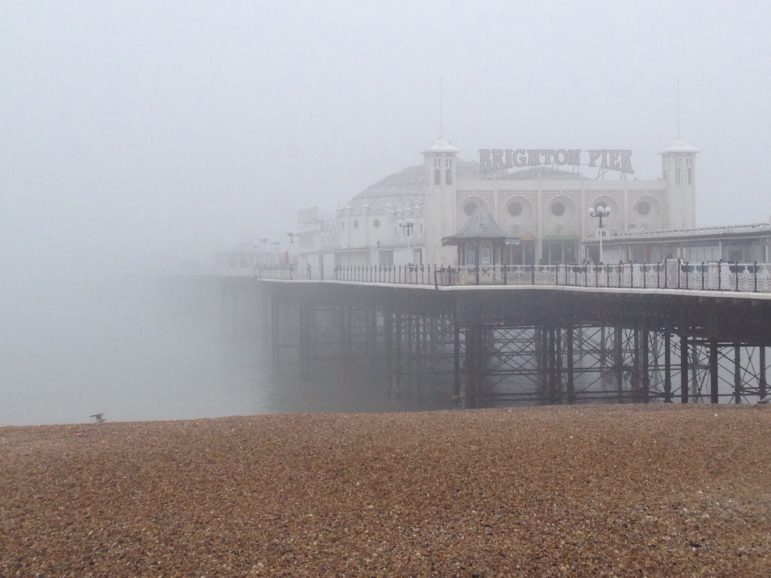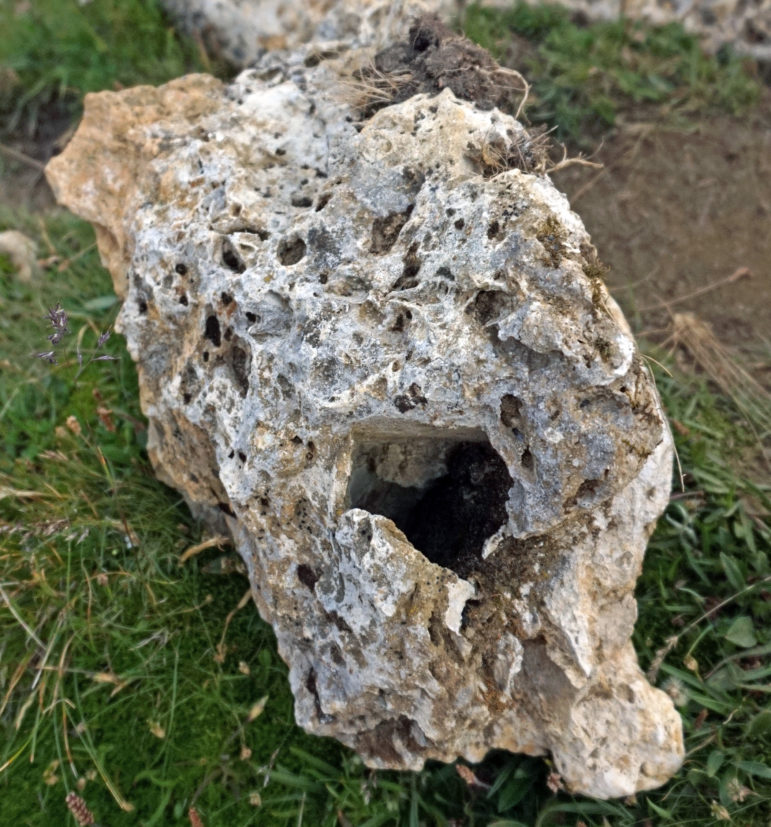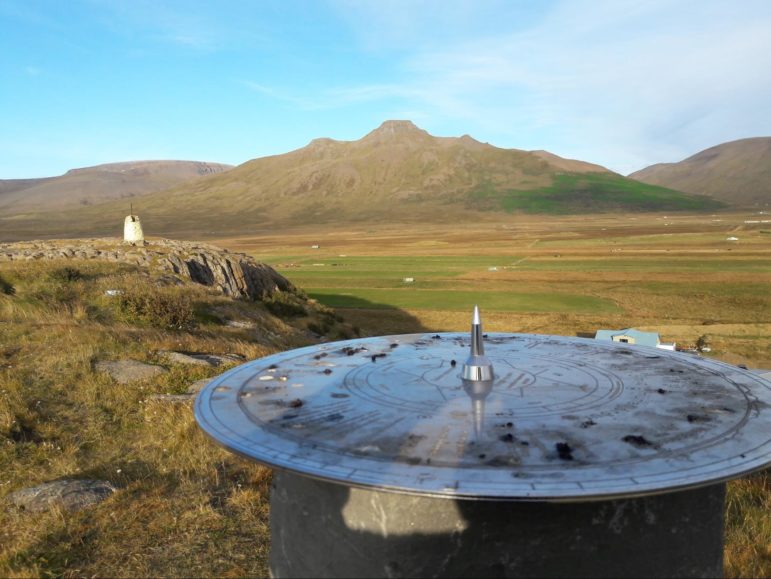
I remember sitting on the edge of the playground as a child and combing through smooth river stones for the one that would let me see the Neighbors. I knew just what it would look like – oblong and almost flat, like a thick coin, with a circular hole worn through the center. It would be light enough that I could hang it from a chain around my neck, and heavy enough that when I put it to my eye there would be a satisfying weight to its cool surface as I looked through. On the other side would be a world like mine, but augmented with the airy mountain men of Yeats and the markets of Rossetti. That stone would be the thing that opened the gate to magic. And so I sifted through rocks that I deemed less enchanted, searching for the pendant that would mark me as special.
There is probably a metaphor here, or at the very least a lesson. The fact is that by the time I found such a stone, a decade later and on another continent, I no longer knew what to do with it. I still thrilled at picking it up, peering through its egglike shape at the beach on the other side, but I knew it would be no different than Brighton I saw on this side of the stone. By then I had long since come to the realization that I would never see my Neighbors.

[Wikimedia Commons.]
This, according to the stories I had read since childhood, was altogether the preferred way of things. Yeats described the Good Neighbors as amoral beings at best, strange and demanding shapes whose appearance heralds a difficult and likely dangerous task ahead, something that could easily change a life for the worse. I had enough of those in my spiritual life already.
When I joined the Pagan community, with its stories of house hobs and small spirits, I consoled myself with the thought that I was plenty busy enough. Besides, hearing someone talk about inviting the Gentry into their home put me in mind of protection rackets, offering food and drink so that the locals didn’t slash any tires. Really, I figured, I was hardly missing out.
Just because I had never encountered the Good Folk did not mean that I did not believe in them. They were too well attested, too thoroughly ensconced in my understanding of magic, for that to be an issue. They did puzzle me, though, in a taxonomical way that, fittingly, evaporated every time I tried to look at it directly. Growing up, I had learned that these beings were angels that had fallen from heaven but had not been quite bad enough to descend entirely into hell. When I left Christianity, my paradigm had no more room to make sense of such moral absolutism, and so the Blessed Folk no longer had a story that made sense to me. I was not even sure if the small spirits that my friends had in their homes could be classed in the same category as the Fair Folk I read about, or if they were a different sort of spiritual fauna native to the streets of the Midwest. I didn’t know what to think of them.
What I knew, and what I was told by every elder who I consulted when planning my trip, was that the comparable beings in Iceland would clean me off the map without thinking twice about it, possibly by means of the side of a mountain. “Take offerings,” I was told by one friend. “Be polite, and thank them for letting you visit.”
“Don’t say a word, don’t make eye contact, and leave quietly,” said another. “The landwights there have a history of protecting their land from foreign witches. Best not to attract attention.” This sounded like fine advice, considering my circumstances: a week in a foreign country, driving on roads well outside of my skill level, and with cell reception that promised to be spotty at best, was already sounding less than wise. I had no interest in earning the ire of the locals, whoever they might be.
As I did my research, I found there certainly seemed to be plenty of local spirits to choose from. The largest contingent in Iceland seemed to be the landvaettir, or nature spirits – both the four that appear in Iceland’s coat of arms and the myriad others that animate Iceland’s wild and varied landscape. These were different from the huldufólk, or hidden people, with their fine clothes and their homes in the large stones of the landscape. These folk sounded the most like the stories of the Good Neighbors to me. Then there were also the spirits of humans who still resided in their graves, as what I understood to be a sort of localized ancestor – not quite the same as the huldufólk, but not quite different.
As I read, each of the sorts of spirit seemed to be distinct, with its own set of rules. Or else they were different names for the same thing. Or else the groups faded into each other around the edges in indefinable and unclear ways. After adding in the jötun and the trolls, I felt a little like I was signing up for a week in a densely populated land whose strict rules of politeness had been passed down to me through a blurry handwritten manuscript that I had only seen once. I was sure to piss someone off, somehow. (At least most sources seemed to agree trolls were no longer much of a problem.)
I had only angered the Good Neighbors once that I knew of. A year before, I had driven with my friends for six hours to a small Pagan campground in Missouri. There, on strange but friendly land, we had built a fire and toasted to our gods in good faith. But I had not brought any gifts for the locals other than the cash I had given the man at the gate. Our ritual went beautifully. The morning after, we woke in shambles. One friend was so dehydrated that they could hardly move, fingers frozen into claws that took hours to become hands again. My glasses were gone, never to be found. We spent the morning pulling ourselves together, trying to prepare for a long ride home. Gifts, we had decided afterwards, were non-negotiable.
When I was packing up my bags for Reykjavik, I filled my pockets with stones: a bag of small ones, polished until they shone, as offerings for any spirits I would happen to meet along the way; four large ones, chosen carefully and wrapped as gifts for the landvaettir, to be left at the cardinal-most points of my trip; two that, together, made the heart of my traveling altar; and one, far more plain than the others, with a hole that ran the length of it, big enough to look through.

[Wikimedia Commons.]
I left the small ones in small places on my journey. One I left at the heart of a cemetery, for the guardian who had been the first buried on the land. Another I left on a wall near the church in Þingvellir. When I turned my back on it, hidden in the moss, I heard a voice say “thank you” clearly, in slightly accented English. I did not turn to scan the crowd.
I left the large ones in the east, in the south, and in the west – and one in the north, as far north as I traveled. That was Skagastrond, a town well off the main road that I had chosen to visit because it was the home of Spakonuhof, a place translated in all of the English literature as the “Icelandic Museum of Prophecies.” I had chosen it from a list of Iceland’s museums, with no real idea of what it was or how difficult it might be to get there. When I drove into town, well past the end of the tourist season, I have no doubt that I was the only stranger for miles.
Spakonuhof was a long metal building on the main road, the only obviously public space besides the gas station. It was also thoroughly closed, with a phone number taped to the door on brightly colored paper. No more than I should have expected, I supposed, but I dialed the number anyway, just because it seemed like a long way to come without at least trying my patchy signal.
Ten minutes later, a woman biked up and nodded to me. She might have been anywhere between forty and seventy – I have never been good at guessing age – and she was businesslike as she looked me over. “You’ve come to hear about Thordis?” she asked, the keys for the building dangling from one hand.
I did not hesitate. “Yes ma’am.”
She nodded again. “Come in,” she said, and led me into the building. I stood in the gift shop, examining the knucklebones of sheep, as she turned the lights on and started the small electric fire in the larger room beyond. It burned at the feet of a waxwork woman, wearing the everyday garb that I had come to associate with spaekona, the women who appeared in the sagas as priestesses or witches, the prophetesses of Iceland’s ancient religion.
I had looked into Thordis’ eyes once already on this trip, in the Saga Museum, but I had not expected to find her again here. She is a familiar figure in certain circles – one of the recurring characters in the Icelandic sagas that is almost certainly based in history. This version of her was less skillfully done than the version in the Saga Museum, but she seemed more powerful, standing at the height of her story by a turf house that had to be her home. It was the only thing in the museum, really, or certainly the highlight, the centerpiece of the building. I waited, looking at her, until my hostess returned to me, took my entry fee, and led me over to Thordis.
The stories she told me are, in many ways, not mine to tell again. Most of them can be found in the sagas, and in the illustrations that circled that room. What I learned was that this town was Thordis’ home, where she lived as a leader and one of the last practitioners of a religion that was slowly being overtaken by Christianity. It was also where she died, at the hands of a priest, on the mountain overlooking town that still bears her name.
My memory will not tell me whether the words my host used were, “Thordis is still on the mountain,” or “Thordis is the mountain.” I do not think it matters. Those words came with me in both forms as I left the long, low building and got into my car.
It was late afternoon by that point, too late to drive into the nearest city or to attempt the hike up the side of the mountain itself, but at the edge of town there was another trail. It led up along a hill and into the cliffs overlooking the sea. This was where my hostess had told me a company had carved too far into the rock, and then the huldufólk had left and taken the fish with them. I climbed that trail with stones in my pockets. One for my offering to the land, at this northernmost point on this trip; I left it on a cliff among a slew of others. One for Thordis, this witch from the past who had stood among heroes in her sagas. I left it in the grass, as I looked out toward her mountain.
I looked toward her through that last stone, as the sun began to set on us both. I saw nothing but the mountain, green and flat-peaked, no shape climbing it in the distance, no flash of light between us. There was nothing to explain the feeling of calm and pleasure, the light sense of amusement that broke through four days of constant low anxiety. I was out of my depth, yes – but that night, at least, my neighbors were as lovely as the land.

[Wikimedia Commons.]
There is probably something useful to say, here, about fear and the ways that it can blind us, or the eye-opening experience of falling in love with a stranger. What I will say instead is this – now I live in a house filled with magical practitioners and frequented by a cohort of spirits whose history I would not presume to guess. I very seldom see my neighbors- but occasionally there is someone who stands in the entryway, dark suited and measuring, guarding the inner door to the house. I only ever glance them out of the corner of my eye, and only on days when my heart is easy, my pockets empty.
The Wild Hunt always welcomes submissions for our weekend section. Please send queries or completed pieces to eric@wildhunt.org.
The views and opinions expressed by our diverse panel of columnists and guest writers represent the many diverging perspectives held within the global Pagan, Heathen and polytheist communities, but do not necessarily reflect the views of The Wild Hunt Inc. or its management.
The Wild Hunt is not responsible for links to external content.
To join a conversation on this post:
Visit our The Wild Hunt subreddit! Point your favorite browser to https://www.reddit.com/r/The_Wild_Hunt_News/, then click “JOIN”. Make sure to click the bell, too, to be notified of new articles posted to our subreddit.